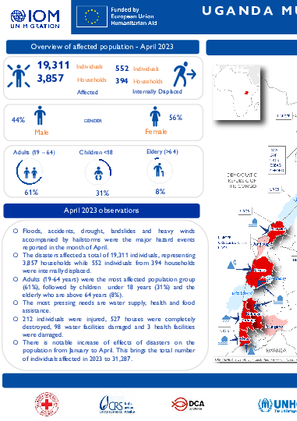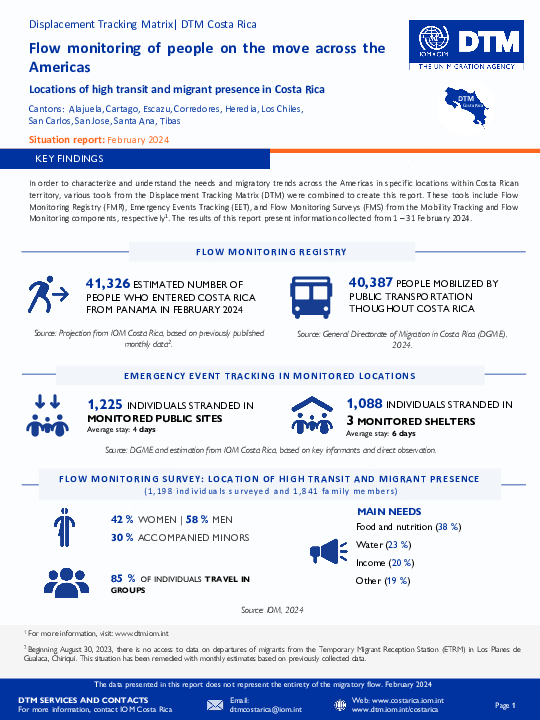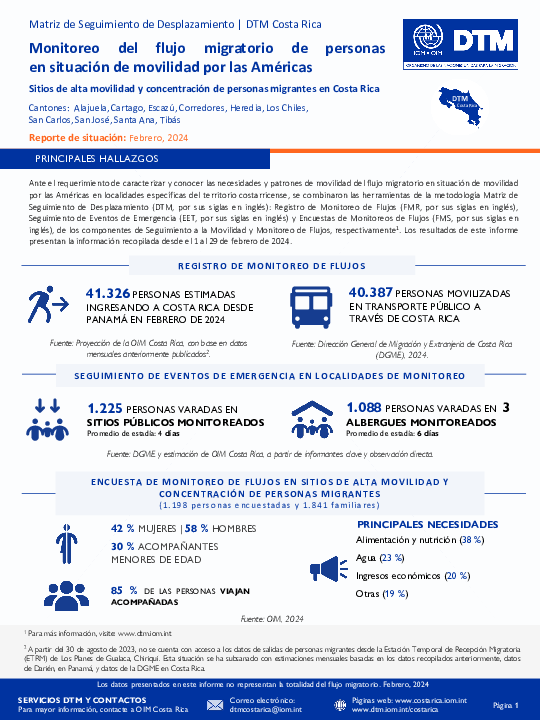-
Countries
-
Data and Analysis
-
Special Focus
-
Crisis Responses
Përmbledhje mujore të:
- Arritjet në Ballkanin Perëndimor
- Tre kombësitë kryesore të arriturëve
- Prania e migrantëve në qendrat pritëse
- Kthimet vullnetare dhe të asistuara
Contact
DTM Pakistan, DTMPakistan@iom.int
Location
Pakistan
Activity
- Mobility Tracking
- Site Assessment
Period Covered
Aug 01 2023 -Aug 31 2023
In round 4, 1,340,621 TDP individuals and 2,633,435 TDP returnees were identified in Khyber Pakhtunkhwa, Balochistan, and Sindh province.
Population Groups
IDPs
Returnee (Previously Internally Displaced)
Survey Methodology
Unit of Analysis Or Observation
Admin Area 2
Admin Area 3
Site or Location
Type of Survey or Assessment
Key Informant
Keywords
Geographical Scope Partial Coverage
Administrative boundaries with available data
The current dataset covers the following administrative boundaries

Contact
DTM Uganda, dtmuganda@iom.int
Language
English
Location
Uganda
Period Covered
Apr 01 2023
Apr 30 2023
Activity
- Mobility Tracking
- Floods, accidents, drought, landslides and heavy winds accompanied by hailstorms were the major hazard events reported in the month of April.
- The disasters affected a total of 19,311 individuals, representing 3,857 households while 552 individuals from 394 households were internally displaced.
- Adults (19 - 64 years) were the most affected population group(61%), followed by children under 18 years (31%) and the elderly who are above 64 years(8%).
- The most pressing needs are water supply, health and food assistance.
- 212 individuals were injured, 527 houses were completely destroyed, 98 water facilities damaged and 3 health facilities were damaged.
- There is notable increase of effects of disasters on the population from January to April. This brings the total number of individuals affected in 2023 to 31,287.
Monthly Overview of:
- Arrivals in the Western Balkans
- Top three nationalities at arrivals in the reporting month
- Migrants presence in reception facilities
- Assisted Voluntary Returns and reintegration

Contact
DTM Uganda, dtmuganda@iom.int
Language
English
Location
Uganda
Period Covered
Feb 01 2023
Feb 28 2023
Activity
- Mobility Tracking
- During the reporting period, drought was reported in the Teso subregion mainly in Katakwi, Amuria and Kapelabyong districts.
- Fires were experienced in Amuria, Wakiso and Ntungamo while hailstorms were reported in Tororo.
- Disasters in February affected a total of 2,890 individuals, representing 494 households and 198 individuals from 51 households were internally displaced.
- Adults (19-64 years) were the most affected population group (71%), followed by children under 18 years (21%) and the elderly who are above 64 years (8%).
- The most pressing needs are food assistance, livelihood and water supply.
- 56 houses were completely destroyed, 54 water facilities and 2 schools were also affected.
- Following the start of March, April and May (MAM) rainfall season, natural disasters are expected to occur and the public is advised to take precautionary measures.
Contact
DTM Sudan, DTMSudan@iom.int
Location
Sudan
Activity
- Mobility Tracking
- Baseline Assessment
Period Covered
Feb 29 2024 -Mar 07 2024
- DTM Sudan estimates that 6,467,700 individuals (1,289,341 households) were recently internally displaced.
- The IDP caseload was observed in 6,968 locations across all of Sudan’s 18 states.
- The highest proportions of IDPs were observed across South Darfur (12%), River Nile (11%), and East Darfur (10%).
- Field teams reported that the IDPs observed were originally displaced from twelve states. The majority (3,564,234 IDPs, 55%) were reportedly displaced from Khartoum state; followed by South Darfur (15%), North Darfur (9%), Aj Jazirah (8%), Central Darfur (5%), West Darfur (4%), South Kordofan (2%), East Darfur (1%), West Kordofan (1%), North Kordofan (1%), Sennar (<1%) and White Nile (<1%).
- IOM-DTM also reported that an estimated 1,918,309 mixed cross-border movements were made into neighbouring countries.
- This product provides brief insights into those displaced in Sudan post-15 April 2023. For more granular information on the IDP caseload and the displacement context, please see IOM-DTM's Monthly Displacement Overview 06.
A more detailed version of this dataset is available, to get access kindly click on the 'Request Access' button
Population Groups
IDPs
Survey Methodology
Unit of Analysis Or Observation
Site or Location
Type of Survey or Assessment
Key Informant
Keywords
Geographical Scope Partial Coverage
Administrative boundaries with available data
The current dataset covers the following administrative boundaries

Contact
DTM Uganda, dtmuganda@iom.int
Language
English
Location
Uganda
Period Covered
Feb 01 2024
Feb 29 2024
Activity
- Mobility Tracking
- In February 2024, floods were reported in the Bukedea district, heavy storms in Lira, Kyotera, Kalangala and Mbale and fires in Mamisidwa and Obongi.
- The impacts of the hazards affected 3,935 individuals (993 households) with 1,525 people from 271 households were internally displaced.
- Adults between 18 and 64 years were the most affected age group (55%), followed by children below 18 (43%) and elderly above 64 (2%). Notably, more than half of affected people were female (54%).
- Urgent needs identified include sanitation, non-food items, food assistance and livelihood promotion.
- Infrastructure damage assessed indicates that 195 houses were completely destroyed, 131 houses were partially damages, 40 water facilities were affected and also 4 schools and 3 health facilities were adversely affected.
- In January 2024, 1,654 individuals were affected bringing the 2024 accumulation to 5,589 individuals.

Contact
DTMCostaRica@iom.int
Language
English
Location
Costa Rica
Period Covered
Feb 01 2024
Feb 29 2024
Activity
- Flow Monitoring
- Mobility Tracking
- Event Tracking
Cantons: Alajuela, Cartago, Escazú, Corredores, Heredia, Los Chiles, San Carlos, San José, Santa Ana, Tibás
Costa Rica, like the other countries in the Central American region, has been characterized as a migratory corridor for people who transit by land from the south to the north of America and whose destination is the countries in the north of the continent. This flow on the move through the Americas is mainly made up of people from the Bolivarian Republic of Venezuela, Cuba, Haiti, Ecuador, as well as people from other countries in South America, Africa and Asia.
According to estimations from IOM Costa Rica, during February 41,326 people entered the country, an approximate average of 1,425 people per day and estimating a increase of 10% compared to January 2024. In addition, 1,088 people stranded in the monitored shelters were identified and 1,225 people stranded in the public places visited.

Contact
Angélica Madrigal amadrigal@iom.int
Language
English
Location
Costa Rica
Period Covered
Feb 01 2024
Feb 29 2024
Activity
- Survey
- Registration
- Flow Monitoring
Cantones: Alajuela, Cartago, Escazú, Corredores, Heredia, Los Chiles, San Carlos, San José, Santa Ana, Tibás
Costa Rica, al igual que los demás países de la región centroamericana, se ha caracterizado por ser un corredor migratorio para personas que transitan de manera terrestre desde el sur hasta el norte de América y que tienen como destino los países del norte del continente. Este flujo en situación de movilidad por las Américas se encuentra compuesto principalmente por personas de la República Bolivariana de Venezuela, Cuba, Haití, Ecuador, así como personas provenientes de otros países de Suramérica, África y Asia.
Según estimaciones de la OIM Costa Rica, durante febrero ingresaron al país 41.326 personas, un promedio aproximado de 1.425 personas por día y estimando un aumento de un 10% con respecto a enero de 2024. Además, se identificaron 1.088 personas varadas en los albergues monitoreados y 1.225 personas varadas en los sitios públicos visitados.
The crisis currently affecting the Lake Chad Basin states results from a complex combination of factors, including conflict with non-state armed groups, extreme poverty, underdevelopment and a changing climate, which together have triggered significant displacement of populations. As of February 2024, Cameroon, Chad, Niger and Nigeria were hosting an estimated 6,031,612 affected individuals made up of internally displaced persons (IDPs), returnees (former IDPs and returnees from abroad) and refugees (both in- and out-of-camp). Thirteen per cent of the affected population (775,238 individuals) were located in Cameroon, while 5 per cent resided in Chad (286,865 individuals), 9 per cent in Niger (513,149 individuals) and finally, 74 per cent in Nigeria (4,456,360 individuals). Overall, the numbers show increases in returnees from abroad (+4%) and a decrease in refugees (-10%) since December 2023.



